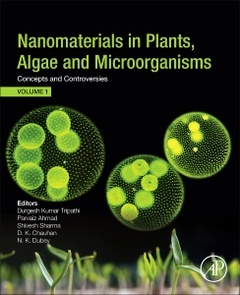Nanomaterials in Plants, Algae, and Microorganisms Concepts and Controversies: Volume 1
Coordonnateurs : Tripathi Durgesh Kumar, Ahmad Parvaiz, Sharma Shivesh, Chauhan Devendra Kumar, Dubey Nawal Kishore

Nanomaterials in Plants, Algae and Microorganisms: Concepts and Controversies: Volume One discusses the vast amount of nanomaterials that have been released into the environment in a relatively short amount of time. There is a need to understand what the implications to the health of our biota and ecosystems are as the earth is increasingly inundated with these materials. Not all of the effects are negative, but their impacts are increasing exponentially due to their size, quantity and other factors.
1. Role of Nanoparticles in crop protection 2. Biological synthesis of nanoparticles and their impact on fungus 3. Role of Silver nanoparticles in different plant diseases 4. Role of nanoparticles in agricultural production and crop protection: Status and scope 5. Antifungal impact of nanoparticles against different plant pathogenic fungi 6. Role of metal Nanoparticles in persuading Arbuscular Mycorrhizal Fungi Effects on Plant Growth 7. Biological synthesis of nanoparticles and their Impacts on plants and soil microorganisms 8. Nanoparticles and plants DNA 9. Impact of fluorescence nanoparticles on living organisms: Recent Advances and Future Opportunities 10. Interaction of nanoparticles and abiotic Stress Tolerant Transgenic Plants: responses and future prospects 11. Response of Iron oxide nanoparticles to plants 12. Nanoparticles and oxidative stress in plants 13. Nanoparticles and their impact on morphology of root and shoot of plants 14. TiO2 nanoparticle biosynthesis, accumulation, translocation and its differing impacts on plants 15. Effects of rare earth oxide nanoparticles on plants 16. Relevance of Carbon Nanotubes in agriculture: Solution Threats and opportunity 17. Impact of nanoparticles on antioxidant defense system of Plants 18. Response of Zero-valent ion nanoparticles to plants 19. Interactions of engineered nanoparticles (ENPs) to plants: Phytotoxicity, uptake and accumulation 20. Perception for nano-biotechnology enabled protection and nutrition of plants 21. Recent progress of Nanotoxicology in Plants 22. Effect of nanoparticles on Phytosynthesis of plants: Role and future possibilities 23. Plant-Based Synthesis of Nanoparticles and their impact 24. Applications of Nanoparticles to enhance plant health and agricultural production 25. Carbon nanotubes as plant growth regulators: impacts on growth, reproductive system, and soil microbial community
Researchers, professionals and students involved in Nanotechnology research, Pollution, Environmental Sciences, Plant Ecophysiology, Plant Biochemistry, Plant Molecular Biology, Plant Microbe Interactions or Soil Pollution
Dr. Durgesh Kumar Tripathi is currently an Associate Professor at Amity Institute of Organic Agriculture, Amity University Uttar Pradesh, Noida, India. He is the recipient of ‘Dr DS Kothari Post-Doctoral Fellowship’ of the UGC, New Delhi. Dr. Tripathi has received his D.Phil. in Science from University of Allahabad, India. During this period, Dr. Tripathi worked extensively on phytolith analysis, crop stress physiology, agro-nanotechnology and molecular biology. He has expertise on laser spectroscopy. His research interests encompass stress tolerance mechanisms in plants. Presently, he is working with nano-materials and their interactions with plants to find out their detoxification mechanisms, he is also working on Silicon, Nitric oxide and hormonal crosstalk against abiotic stress in plants.
Dr. Parvaiz Ahmad is Senior Assistant Professor in the Department of Botany at Sri Pratap College, Srinagar, Jammu and Kashmir, India, and is presently a Visiting Scientist at King Saud University, Riyadh, Saudi Arabia. He completed his post-graduate degree in Botany in 2000 at Jamia Hamdard, New Delhi, India. After receiving a Doctorate degree from the Indian Institute of Technology (IIT), Delhi, India, he joined the International Centre for Genetic Engineering and Biotechnology, New Delhi, in 2007. His main research area is Stress Physiology and Molecular Biology. He has published more than 50 research papers in peer reviewed journals, and 40 book chapters. He is also an Editor of 17 volumes (one with Studium Press Pvt. India Ltd., New Delhi, India; nine with Springer, New York; three with Elsevier USA; and four with John Wiley & Sons, Ltd.). He is a recipient of the Junior Research Fellowship and Senior Research Fellowship award, granted by CSIR, New Delhi, India. Dr. Ahmad was awarded the Young Scientist Award under the Fast Track scheme in 2007 by the Department of Science and Technology (DST), Govt. of India. Dr. Ahmad is actively engaged in studying the molec
- Covers the issues of nanoparticles on more simple organisms and their ecosystems
- Presents issues that are specific to terrestrial ecosystems
- Contains contributions from global experts who help increase understanding at the physiological, biochemical, molecular, and even genomic and proteomic levels
- Provides a critical assessment of the progress taking place on this topic and sheds light on future research needs
Date de parution : 11-2017
Ouvrage de 550 p.
19x23.3 cm
Mots-clés :
Absorbance; Accumulation; Acid-functionalized metal oxides; Agriculture; Agrochemicals; Agronomy; Anthropic activities; Bifunctional catalysts; Bioaccumulation; Bioactive molecule; Biological applications; Biomagnification; Biosensors; Carbon nanotubes; Crop yield quality; Crop; CuO NPs; Delivery applications; DNA nanostructures; Eco-friendly; Endocytic pathway; Endocytosis; Engineered nanoparticles; Environmental contamination; Essential oil; Exocytosis; Food packaging; Food sector; Food system; Fossil fuels; Gold nanoparticles; Green synthesis; Iron oxide nanoparticles; Legume-rhizobium symbiosis; Marketing site; Mathematical problems; Metallic nanoparticles; Microcapsule; Mixed metal oxides; Morphology; Multigenerational studies; Nanocatalysts; Nanocomposites; Nanoemulsions; Nanoencapsulation; Nanomaterial; Nanomaterials; Nanoparticles; Nanotechnology; nCeO2Plant growth; Nonmetallic nanoparticles; Organic matter conversion; Pest; Pesticide; Pests; Phytotoxicity; Plant biomass; Plant parts; Plant pathogen; Plant response; Plant-based nanoparticle synthesis; Plant-based synthesis; Plant-mediated nanoparticles; Plants; Positive and negative impacts; Production site; Raman spectroscopy; Rapid; and low-cost attributes; Rare earth oxide nanoparticles; Recent advances; Root elongation; Roots; Seed germinationSeed germination; Sequence mismatch; Shoots; Silver nanoparticles; Spectroscopy; Surface coating; Sustainable yield; Tolerance mechanism; Toxicity; Transfer; Translocation; Uptake translocation and accumulation; Uptake; Zinc oxide



